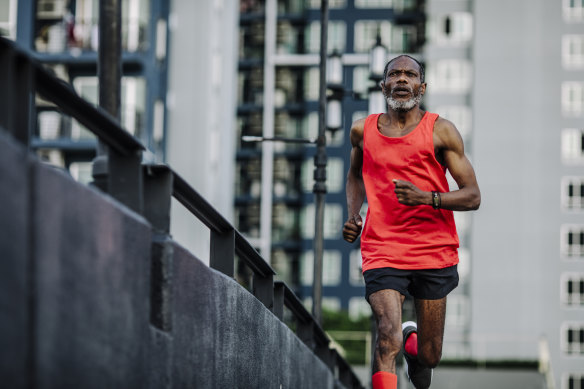Save articles for later
Add articles to your saved list and come back to them any time.
I ran my first – and only – marathon eight years ago. This time around, at 38, I’m more wary of injury, so I have taken my training very seriously, engaging a crack squad of experts from the gym BodySpace to help.
The most surprising thing the performance team told me? To cut down on my running time, to spend more time at the weights rack. That – and the pleasing news that I need to up my carb intake.
If you’re thinking about doing a marathon, or even want to just get better at running, try these tips.Credit: iStock
The result has been injury-free training and faster times. Here are their six tips that anyone, from a casual jogger to a seasoned pro, can use to improve their running.
1. Run less, but smarter and faster
There’s a tendency to try to do too much, too soon when you start – or restart – running. “High volume and repetitive impact of running can cause an increased risk of injury to a middle-aged runner, who might potentially have weak stabiliser muscles and poor posture,” says Tom Cheeseman, lifestyle performance director at UK gym Bodyspace.
Instead, he says, cut the number of runs per week (I had been following an app that recommended four or five runs for marathon training, Cheeseman cut me down to three; if you’re not event training you can do less), but include a speed session. “Your body will get better at transporting oxygen, or in technical terms, your VO2 max will improve,” Cheeseman explains. The more efficient your body becomes at transporting the oxygen around your body efficiently, the faster and longer you can run.
I’ve noticed a huge difference in my speed and stamina after including speed sessions. But how do you do it? It’s all about working out how tough a speed feels for you – rather than relying on a number on your treadmill or watch (but I have found both can help to keep your pace at a constant speed).
The best way to up your speed is by interval training, switching between a fast and then more leisurely pace. Cheeseman says aim for a perceived effort level of 8-9/10 for each interval, before taking it back to a comfortable pace. For a beginner, the sprints can be as short as 10-12 seconds, with a couple of minutes walking between if you need to; for the more advanced runners, try a set distance, such as a fast run for 1km, then dropping down to a walk or slow jog.
Another great way to up your speed is through a tempo or threshold run. This is runner’s lingo for an “uncomfortably fast run, but not a sprint”. “These are performed at your 10km pace – so faster than a jog – and require a sustained level of effort.” Run for around 30-45 minutes. I have been doing one interval session and one tempo run per week in the build up to the marathon.
2. Activate your glutes
We might do a cursory stretch before a run, but what matters more, I’ve learned, is a glute activation session to fire up lazy butt muscles using Pilates moves. “The stronger your glutes, the more power you will have in your stride,” says Elisa Grosso, a qualified Pilates instructor and lifestyle performance coach at Bodyspace.
Activating your glutes can make a significant difference.Credit: iStock
The glutes stabilise and support the lower limbs, including your hips’ strength and stability, so help prevent injury. “Weak or inhibited glute muscles can result in a multitude of injuries, from knee pain, which can lead to cartilage damage, changing the femur (thigh bone) alignment, which can cause issues such as shin splints,” says Grosso. Weak glutes are also a big cause of lower back pain, because the back isn’t as supported as it should be.
Building up your glutes will not only prevent injury, but will also reduce the load on your lower leg muscles – meaning you won’t tire as quickly.
Grosso suggests a short Pilates sequence before you set off, using a light resistance band, including glute bridges, side-lying leg lifts and single leg circles.
3. Eat white carbs
It’s rare, these days, to hear a nutritionist giving the thumbs up to white bread, white rice and potatoes. They’ve been vilified thanks to their quick-release energy, but this is precisely the reason they’re a runner’s secret weapon. Nutritionist Lauren Windas says that runners need to embrace them. “My overall tip for middle-aged people looking to improve their running is to ensure that they fuel themselves appropriately,” she says.
“If you’re putting in the distance, it’s not the time to go on an extremely low-calorie diet, and don’t be scared of carbs – you burn them up first.”
Windas advises eating about an hour or so before a long run. Fill half your plate with quick-releasing carbs, such as potatoes without the skin (because fibre before a run can lead to digestion issues), or white rice or pasta; a quarter of the plate with protein and a quarter with low-fibre vegetables such as well cooked carrots, along with a tablespoon of healthy fats such as extra-virgin olive oil. Be warned that if you’re looking to lose weight, it’s not a time to eat mountains of food, but Windas says these proportions on a plate will work for any runner.
If you’re out for more than two hours, you need to take snacks – you’ll need 60g carbohydrate per hour, which could look like four dates or two sports gel sachets, “and always try and take in these carbs before you notice yourself hitting a wall or feeling fatigued,” Windas adds.
4. Add strength training
I’ve seen a huge difference after replacing one run with a weekly strength training session, particularly working on trunk strength and balance.
While you might not think you use your core much in running, Cheeseman says trunk exercises – for your chest, core and back – can help with stamina. “Poor posture and weak muscles in your trunk will mean you will tire faster,” he says. He recommends walking with a kettlebell in one hand, away from the body.
Cheeseman says that leg exercises, such as squats, are obviously important to help with running power, but that single leg exercises are also brilliant to help with balance (running is, after all, balancing on one leg and then the other). He recommends split squats along with single leg Romanian deadlifts.
Slowly increasing your distance can help you build up your range.Credit: iStock
He adds that for a midlifer worried about injury, strength training is essential. “Resistance training adds strength to connective tissue, bones and the surrounding musculature, improving resilience when under stress due to the repetitive nature of running.”
5. Slowly increase your distance
It’s tempting when starting a new programme – or setting a big goal – to attack it with zeal and go all out, too fast. But Cheeseman says increasing your distance by 1.5 to two kilometres per week is enough – and that you only need to do one long run a week.
“Building up gradually will increase your endurance, but also reduce your risk of injuries.” He adds that it’s essential to build up your fitness before throwing a long run of over an hour into the mix. And the further you’re running, the more important the running shoe.
6. Foam-rolling is no fun – but it’s essential
This is the tip I like least – because it hurts – but it really works.
It can feel like an instrument of torture but a foam roller is a cheap, at-home alternative to a sports massage and really helps your legs recover faster after a long run, especially when paired with a cooling massage oil. Lululemon have a stylish version and a Theragun is a high-tech version.
Tight IT bands – which run down the outside of your thigh – can lead to crippling pains, but are, in the most part, prevented by stretching; similarly with tight hip flexors and this is where a foam roller is pure gold.
Cheeseman tells me to foam roll after every long run, working along each quad independently, down the IT band and on my calves. “The targeted muscle should be rolled over at the same speed as a deep tissue massage – roughly one second for every inch of movement,” he says.
It’s excruciating but worth it.
This piece first appeared in The London Telegraph
Make the most of your health, relationships, fitness and nutrition with our Live Well newsletter. Get it in your inbox every Monday.
Most Viewed in Lifestyle
From our partners
Source: Read Full Article



